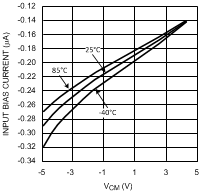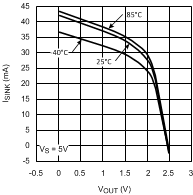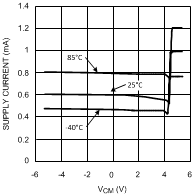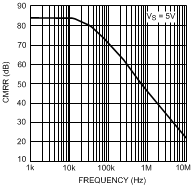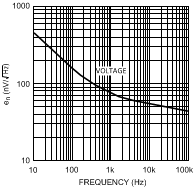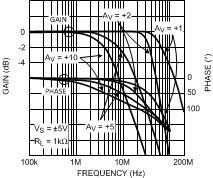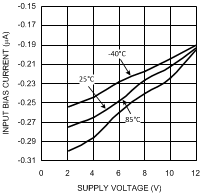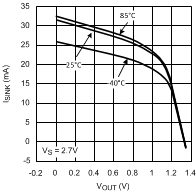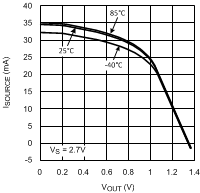SNOSA87C October 2003 – October 2016 LMV116 , LMV118
PRODUCTION DATA.
6 Specifications
6.1 Absolute Maximum Ratings
over operating free-air temperature range (unless otherwise noted)(1)(2)| MIN | MAX | UNIT | ||
|---|---|---|---|---|
| Supply voltage (V+ - V−) | 12.6 | V | ||
| Voltage at INPUT and OUTPUT pins | V− −0.8 | V+ + 0.8 | V | |
| Output short-circuit duration | See(3), (4) | |||
| Junction temperature(5) | 150 | °C | ||
| Soldering information | Infrared or convection (20 seconds) | 235 | °C | |
| Wave soldering lead temperature (10 seconds) | 260 | °C | ||
| Storage temperature, Tstg | –65 | 150 | °C | |
(1) Stresses beyond those listed under Absolute Maximum Ratings may cause permanent damage to the device. These are stress ratings only, which do not imply functional operation of the device at these or any other conditions beyond those indicated under Recommended Operating Conditions. Exposure to absolute-maximum-rated conditions for extended periods may affect device reliability.
(2) If Military/Aerospace specified devices are required, contact the TI Sales Office/ Distributors for availability and specifications.
(3) Applies to both single-supply and split-supply operation. Continuous short circuit operation at elevated ambient temperature can result in exceeding the maximum allowed junction temperature of 150°C.
(4) Output short circuit duration is infinite for VS < 6 V at room temperature and below. For VS > 6 V, allowable short circuit duration is 1.5 ms.
(5) The maximum power dissipation is a function of TJ(MAX), RθJA, and TA. The maximum allowable power dissipation at any ambient temperature is PD = (TJ(MAX) – TA) / RθJA . All numbers apply for packages soldered directly onto a PC board.
6.2 ESD Ratings
| VALUE | UNIT | |||
|---|---|---|---|---|
| V(ESD) | Electrostatic discharge | Human-body model (HBM), per ANSI/ESDA/JEDEC JS-001(1) | ±2000 | V |
| Machine model | ±200 | |||
(1) JEDEC document JEP155 states that 500-V HBM allows safe manufacturing with a standard ESD control process.
6.3 Recommended Operating Conditions
over operating free-air temperature range (unless otherwise noted)| MIN | NOM | MAX | UNIT | ||
|---|---|---|---|---|---|
| Supply voltage (V+ – V−) | 2.5 | 12 | V | ||
| Temperature(1) | −40 | 85 | °C | ||
6.4 Thermal Information
| THERMAL METRIC(1) | LMV116 | LMV118 | UNIT | |
|---|---|---|---|---|
| DBV (SOT-23) | DBV (SOT-23) | |||
| 5 PINS | 6 PINS | |||
| RθJA | Junction-to-ambient thermal resistance | 182.7 | 182.7 | °C/W |
| RθJC(top) | Junction-to-case (top) thermal resistance | 139.9 | 139.9 | °C/W |
| RθJB | Junction-to-board thermal resistance | 41.4 | 41.4 | °C/W |
| ψJT | Junction-to-top characterization parameter | 28.5 | 28.5 | °C/W |
| ψJB | Junction-to-board characterization parameter | 40.9 | 40.9 | °C/W |
(1) For more information about traditional and new thermal metrics, see Semiconductor and IC Package Thermal Metrics.
6.5 Electrical Characteristics: 2.7 V
Unless otherwise specified, all limits apply for TJ = 25°C, V+ = 2.7 V, V− = 0 V, VCM = VO = V+ / 2, and RF = 2 kΩ, andRL = 1 kΩ to V+ / 2.
| PARAMETER | TEST CONDITIONS | MIN(1) | TYP(2) | MAX(1) | UNIT | |
|---|---|---|---|---|---|---|
| VOS | Input offset voltage | 0 V ≤ VCM ≤ 1.7 V | ±1 | ±5 | mV | |
| 0 V ≤ VCM ≤ 1.7 V –40°C to 85°C |
±6 | |||||
| TC VOS | Input offset average drift | See(3) | ±5 | μV/C | ||
| IB | Input bias current | See(4) | −2 | −0.4 | μA | |
| See(4), –40°C to 85°C | –2.2 | |||||
| IOS | Input offset current | 1 | 500 | nA | ||
| CMRR | Common mode rejection ratio | VCM stepped from 0 V to 1.55 V | 73 | 88 | dB | |
| PSRR | Power supply rejection ratio | V+ = 2.7 V to 3.7 V or V− = 0 V to −1 V | 72 | 85 | dB | |
| RIN | Common mode input resistance | 3 | MΩ | |||
| CIN | Common mode input capacitance | 2 | pF | |||
| CMVR | Input common-mode voltage range | CMRR ≥ 50 dB | −0.3 | 1.7 | V | |
| CMRR ≥ 50 dB, –40°C to 85°C | –0.1 | |||||
| AVOL | Large signal voltage gain | VO = 0.35 V to 2.35 V | 73 | 87 | dB | |
| VO = 0.35 V to 2.35 V, –40°C to 85°C | 70 | |||||
| VO | Output swing high | RL = 1 kΩ to V+/2 | 2.55 | 2.66 | V | |
| RL = 10 kΩ to V+/2 | 2.68 | |||||
| Output swing low | RL = 1 kΩ to V+/2 | 150 | 40 | mV | ||
| RL = 10 kΩ to V+/2 | 20 | |||||
| ISC | Output short-circuit current | Sourcing to V−
VID = 200 mV(5) |
25 | 35 | mA | |
| Sinking to V+
VID = −200 mV(5) |
25 | 32 | ||||
| IOUT | Output current | VOUT = 0.5 V from rails | ±20 | mA | ||
| IS | Supply current | Normal operation | 600 | 900 | μA | |
| Shutdown mode (LMV118) | 15 | 50 | ||||
| SR | Slew rate (6) | AV = +1, VO = 1 VPP | 40 | V/μs | ||
| BW | −3 dB BW | AV = +1, VOUT = 200 mVPP | 45 | MHz | ||
| en | Input-referred voltage noise | f = 100 kHz | 40 | nV/√Hz | ||
| f = 1 kHz | 60 | |||||
| in | Input-referred current noise | f = 100 kHz | 0.75 | pA/√Hz | ||
| f = 1 kHz | 1.2 | |||||
| ton | Turnon time (LMV118) | 250 | ns | |||
| toff | Turnoff time (LMV118) | 560 | ns | |||
| THSD | Shutdown threshold (LMV118) | IS ≤ 50 μA | 1.95 | 2.3 | V | |
| ISD | SHUTDOWN pin input current (LMV118) | See(4) | −20 | μA | ||
(1) All limits are specified by testing or statistical analysis.
(2) Typical values represent the most likely parametric norm.
(3) Offset voltage average drift determined by dividing the change in VOS at temperature extremes into the total temperature change.
(4) Positive current corresponds to current flowing into the device.
(5) Short-circuit test is a momentary test. See Absolute Maximum Ratings, note 4.
(6) Slew rate is the average of the rising and falling slew rates.
6.6 Electrical Characteristics: 5 V
Unless otherwise specified, all limits apply for TJ = 25°C, V+ = 5 V, V− = 0 V, VCM = VO = V+/2, and RF = 2 kΩ, and RL = 1 kΩ to V+/2.| PARAMETER | TEST CONDITIONS | MIN(1) | TYP(2) | MAX(1) | UNIT | |
|---|---|---|---|---|---|---|
| VOS | Input offset voltage | 0 V ≤ VCM ≤ 1.7 V | ±1 | ±5 | mV | |
| 0 V ≤ VCM ≤ 1.7 V –40°C to 85°C |
±6 | |||||
| TC VOS | Input offset average drift | See(3) | ±5 | μV/C | ||
| IB | Input bias current | See(4) | −2 | −0.4 | μA | |
| See(4), –40°C to 85°C | –2.2 | |||||
| IOS | Input offset current | 1 | 500 | nA | ||
| CMRR | Common mode rejection ratio | VCM stepped from 0 V to 3.8 V | 77 | 85 | dB | |
| PSRR | Power supply rejection ratio | V+ = 5 V to 6 V or V− = 0 V to −1 V | 72 | 95 | dB | |
| RIN | Common mode input resistance | 3 | MΩ | |||
| CIN | Common mode input capacitance | 2 | pF | |||
| CMVR | Input common-mode voltage range | CMRR ≥ 50 dB | −0.3 | 4 | V | |
| CMRR ≥ 50 dB, –40°C to 85°C | –0.1 | |||||
| AVOL | Large signal voltage gain | VO = 1.5 V to 3.5 V | 73 | 87 | dB | |
| VO = 1.5 V to 3.5 V, –40°C to 85°C | 70 | |||||
| VO | Output swing high | RL = 1 kΩ to V+/2 | 4.8 | 4.95 | V | |
| RL = 10 kΩ to V+/2 | 4.98 | |||||
| Output swing low | RL = 1 kΩ to V+/2 | 200 | 50 | mV | ||
| RL = 10 kΩ to V+/2 | 20 | |||||
| ISC | Output short-circuit current | Sourcing to V−
VID = 200 mV(5) |
35 | 45 | mA | |
| Sinking to V+
VID = –200 mV(5) |
35 | 43 | ||||
| IOUT | Output current | VOUT = 0.5 V from rails | ±20 | mA | ||
| IS | Supply current | Normal operation | 600 | 900 | μA | |
| Shutdown mode (LMV118) | 10 | 50 | ||||
| SR | Slew rate (6) | AV = +1, VO = 1 VPP | 40 | V/μs | ||
| BW | −3 dB BW | AV = +1, VOUT = 200 mVPP | 45 | MHz | ||
| en | Input-referred voltage noise | f = 100 kHz | 40 | nV/√Hz | ||
| f = 1 kHz | 60 | |||||
| in | Input-referred current noise | f = 100 kHz | 0.75 | pA/√Hz | ||
| f = 1 kHz | 1.2 | |||||
| ton | Turnon time (LMV118) | 210 | ns | |||
| toff | Turnoff time (LMV118) | 500 | ns | |||
| THSD | Shutdown threshold (LMV118) | IS ≤ 50 μA | 4.25 | 4.6 | V | |
| ISD | SHUTDOWN pin input current (LMV118) | See(4) | −20 | μA | ||
(1) All limits are specified by testing or statistical analysis.
(2) Typical values represent the most likely parametric norm.
(3) Offset voltage average drift determined by dividing the change in VOS at temperature extremes into the total temperature change.
(4) Positive current corresponds to current flowing into the device.
6.7 Electrical Characteristics: ±5 V
Unless otherwise specified, all limits apply for TJ = 25°C, V+ = 5 V, V− = –5 V, VCM = VO = 0 V, and RF = 2 kΩ, and RL = 1 kΩ to V+/2.| PARAMETER | TEST CONDITIONS | MIN(1) | TYP(2) | MAX(1) | UNIT | |
|---|---|---|---|---|---|---|
| VOS | Input offset voltage | 0 V ≤ VCM ≤ 1.7 V | ±1 | ±5 | mV | |
| 0 V ≤ VCM ≤ 1.7 V –40°C to 85°C |
±6 | |||||
| TC VOS | Input offset average drift | See(3) | ±5 | μV/C | ||
| IB | Input bias current | See(4) | −2 | −0.4 | μA | |
| See(4), –40°C to 85°C | –2.2 | |||||
| IOS | Input offset current | 3 | 500 | nA | ||
| CMRR | Common mode rejection ratio | VCM stepped from 0 V to 3.8 V | 78 | 104 | dB | |
| PSRR | Power supply rejection ratio | V+ = 5 V to 6 V or V− = 0 V to −1 V | 72 | 95 | dB | |
| RIN | Common mode input resistance | 3 | MΩ | |||
| CIN | Common mode input capacitance | 2 | pF | |||
| CMVR | Input common-mode voltage range | CMRR ≥ 50 dB | −5.3 | 4 | V | |
| CMRR ≥ 50 dB, –40°C to 85°C | –5.1 | |||||
| AVOL | Large signal voltage gain | VO = 1.5 V to 3.5 V | 74 | 85 | dB | |
| VO = 1.5 V to 3.5 V, –40°C to 85°C | 71 | |||||
| VO | Output swing high | RL = 1 kΩ to V+/2 | 4.7 | 4.92 | V | |
| RL = 10 kΩ to V+/2 | 4.97 | |||||
| Output swing low | RL = 1 kΩ to V+/2 | –4.7 | –4.92 | V | ||
| RL = 10 kΩ to V+/2 | –4.98 | |||||
| ISC | Output short-circuit current | Sourcing to V−
VID = 200 mV(5) |
40 | 57 | mA | |
| Sinking to V+
VID = −200 mV(5) |
40 | 54 | ||||
| IOUT | Output current | VOUT = 0.5 V from rails | ±20 | mA | ||
| IS | Supply current | Normal operation | 600 | 900 | μA | |
| Shutdown mode (LMV118) | 15 | 50 | ||||
| SR | Slew rate (6) | AV = 1, VO = 1 VPP | 35 | V/μs | ||
| BW | −3 dB BW | AV = 1, VOUT = 200 mVPP | 45 | MHz | ||
| en | Input-referred voltage noise | f = 100 kHz | 40 | nV/√Hz | ||
| f = 1 kHz | 60 | |||||
| in | Input-referred current noise | f = 100 kHz | 0.75 | pA/√Hz | ||
| f = 1 kHz | 1.2 | |||||
| ton | Turnon time (LMV118) | 200 | ns | |||
| toff | Turnoff time (LMV118) | 700 | ns | |||
| THSD | Shutdown threshold (LMV118) | IS ≤ 50 μA | 4.25 | 4.6 | V | |
| ISD | SHUTDOWN pin input current (LMV118) | See(4) | −20 | μA | ||
(1) Typical values represent the most likely parametric norm.
(2) Offset voltage average drift determined by dividing the change in VOS. All limits are specified by testing or statistical analysis.
(3) at temperature extremes into the total temperature change.
(4) Positive current corresponds to current flowing into the device.
(5) Short-circuit test is a momentary test. See Absolute Maximum Ratings, note 4.
6.8 Typical Characteristics
At TJ = 25°C. Unless otherwise specified.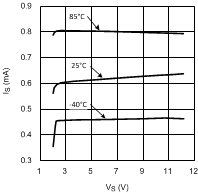
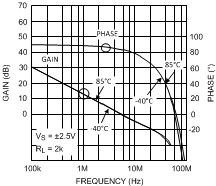
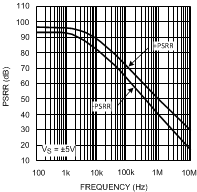
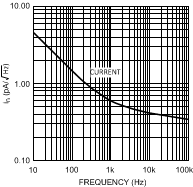
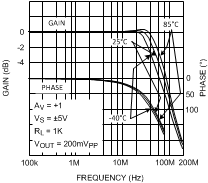
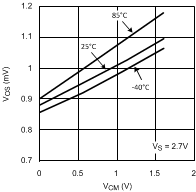
(a Typical Unit)
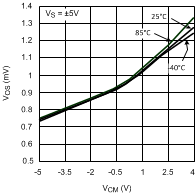
(a Typical Unit)
